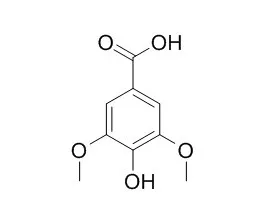| Animal Research: |
| Food Funct. 2016 Feb;7(2):689-97. | | Anti-steatotic and anti-inflammatory roles of syringic acid in high-fat diet-induced obese mice.[Pubmed: 26838182 ] | This study examined the effects of Syringic acid (SA) on obese diet-induced hepatic dysfunction.
METHODS AND RESULTS:
Mice were fed high-fat diet (HFD) with or without SA (0.05%, wt/wt) for 16 weeks. SA reduced the body weight, visceral fat mass, serum levels of leptin, TNFα, IFNγ, IL-6 and MCP-1, insulin resistance, hepatic lipid content, droplets and early fibrosis, whereas it elevated the circulation of adiponectin. SA down-regulated lipogenic genes (Cidea, Pparγ, Srebp-1c, Srebp-2, Hmgcr, Fasn) and inflammatory genes (Tlr4, Myd88, NF-κB, Tnfα, Il6), whereas it up-regulated fatty acid oxidation genes (Pparα, Acsl, Cpt1, Cpt2) in the liver. SA also decreased hepatic lipogenic enzyme activities and elevated fatty acid oxidation enzyme activities relative to the HFD group.
CONCLUSIONS:
These findings suggested that dietary SA possesses anti-obesity, anti-inflammatory and anti-steatotic effects via the regulation of lipid metabolic and inflammatory genes. SA is likely to be a new natural therapeutic agent for obesity or non-alcoholic liver disease. | | Int Surg. 2015 May;100(5):891-6. | | Antioxidant Activity of Syringic Acid Prevents Oxidative Stress in l-arginine-Induced Acute Pancreatitis: An Experimental Study on Rats.[Pubmed: 26011211] | The aim of this study was to investigate the possible protective role of antioxidant treatment with Syringic acid (SA) on l-arginine-induced acute pancreatitis (AP) using biochemical and histopathologic approaches.
METHODS AND RESULTS:
A total of 30 rats were divided into 3 groups. The control group received normal saline intraperitoneally. The AP group was induced by 3.2 g/kg body weight l-arginine intraperitoneally, administered twice with an interval of 1 hour between administrations. The AP plus SA group, after having AP induced by 3.2 g/kg body weight l-arginine, was given SA (50 mg kg(-1)) in 2 parts within 24 hours. The rats were killed, and pancreatic tissue was removed and used in biochemical and histopathologic examinations. Compared with the control group, the mean pancreatic tissue total oxidant status level, oxidative stress index, and lipid hydroperoxide levels were significantly increased in the AP group, being 30.97 ± 7.13 (P < 0.05), 1.76 ± 0.34 (P < 0.0001), and 19.18 ± 4.91 (P < 0.01), respectively. However, mean total antioxidant status and sulfhydryl group levels were significantly decreased in the AP group compared with the control group, being 1.765 ± 0.21 (P < 0.0001) and 0.21 ± 0.04 (P < 0.0001), respectively. SA reduces oxidative stress markers and has antioxidant effects.
CONCLUSIONS:
It also augments antioxidant capacity in l-arginine-induced acute toxicity of pancreas in rats. | | Naunyn Schmiedebergs Arch Pharmacol. 2012 Dec;385(12):1175-84. | | Syringic acid ameliorates (L)-NAME-induced hypertension by reducing oxidative stress.[Pubmed: 23079793] | The objective of the present study was to investigate the effects of Syringic acid (SA), a phenolic acid, on N(ω)-nitro-L-arginine methyl ester (L-NAME)-induced hypertensive rats.
METHODS AND RESULTS:
Hypertension was induced in adult male albino rats by oral administration of L-NAME (40 mg/kg/day) dissolved in drinking water daily for 4 weeks.
Rats were treated with different doses of SA (25, 50, and 100 mg/kg body weight (b.w.)). Systolic blood pressure of control and experimental rats was recorded. Plasma nitric oxide metabolites (NOx), lipid peroxidative products such as thiobarbituric acid reactive substances, lipid hydroperoxides, conjugated dienes, and antioxidants such as superoxide dismutase, catalase, glutathione peroxidase, vitamin C, vitamin E, and reduced glutathione were estimated in erythrocytes, plasma, and tissues of experimental rats. Hepatic marker enzymes such as aspartate aminotransferase, alanine aminotransferase, and alkaline phosphatase and renal functional markers such as urea, uric acid, and creatinine were also estimated in serum. The increased levels of blood pressure, lipid peroxidation products, hepatic and renal function markers, and the decreased level of NOx and antioxidants in L-NAME-induced hypertensive rats were reversed upon SA treatment. The protective effect at the dose of the three tested doses (25, 50, and 100 mg/kg) of SA at a dose of 50 mg/kg b.w. exerts optimum protection. Biochemical findings are substantiated by the histological observation.
CONCLUSIONS:
The protective effects of SA are mediated by reducing oxidative stress and retaining the bioavailability of NO in the cardiovascular system. | | Biol Pharm Bull. 2010;33(6):983-7. | | Hepatoprotective effect of syringic acid and vanillic acid on CCl4-induced liver injury.[Pubmed: 20522963] | The mycelia of the edible mushroom Lentinula edodes can be cultured in solid medium containing lignin, and the hot-water extracts (L.E.M.) is commercially available as a nutritional supplement.
METHODS AND RESULTS:
During the cultivation, phenolic compounds, such as Syringic acid and vanillic acid, were produced by lignin-degrading peroxidase secreted from L. edodes mycelia. Since these compounds have radical scavenging activity, we examined their protective effect on oxidative stress in mice with CCl(4)-induced liver injury. We examined the hepatoprotective effect of Syringic acid and vanillic acid on CCl(4)-induced chronic liver injury in mice. The injection of CCl(4) into the peritoneal cavity caused an increase in the serum aspartate aminotransferase (AST) and alanine aminotransferase (ALT) levels. The intravenous administration of Syringic acid and vanillic acid significantly decreased the levels of the transaminases. Four weeks of CCl(4) treatment caused a sufficiently excessive deposition of collagen fibrils. An examination of Azan-stained liver sections revealed that Syringic acid and vanillic acid obviously suppressed collagen accumulation and significantly decreased the hepatic hydroxyproline content, which is the quantitative marker of fibrosis. Both of these compounds inhibited the activation of cultured hepatic stellate cells, which play a central role in liver fibrogenesis, and maintained hepatocyte viability.
CONCLUSIONS:
These data suggest that the administration of Syringic acid and vanillic acid could suppress hepatic fibrosis in chronic liver injury. |
|






 Cell. 2018 Jan 11;172(1-2):249-261.e12. doi: 10.1016/j.cell.2017.12.019.IF=36.216(2019)
Cell. 2018 Jan 11;172(1-2):249-261.e12. doi: 10.1016/j.cell.2017.12.019.IF=36.216(2019) Cell Metab. 2020 Mar 3;31(3):534-548.e5. doi: 10.1016/j.cmet.2020.01.002.IF=22.415(2019)
Cell Metab. 2020 Mar 3;31(3):534-548.e5. doi: 10.1016/j.cmet.2020.01.002.IF=22.415(2019) Mol Cell. 2017 Nov 16;68(4):673-685.e6. doi: 10.1016/j.molcel.2017.10.022.IF=14.548(2019)
Mol Cell. 2017 Nov 16;68(4):673-685.e6. doi: 10.1016/j.molcel.2017.10.022.IF=14.548(2019)